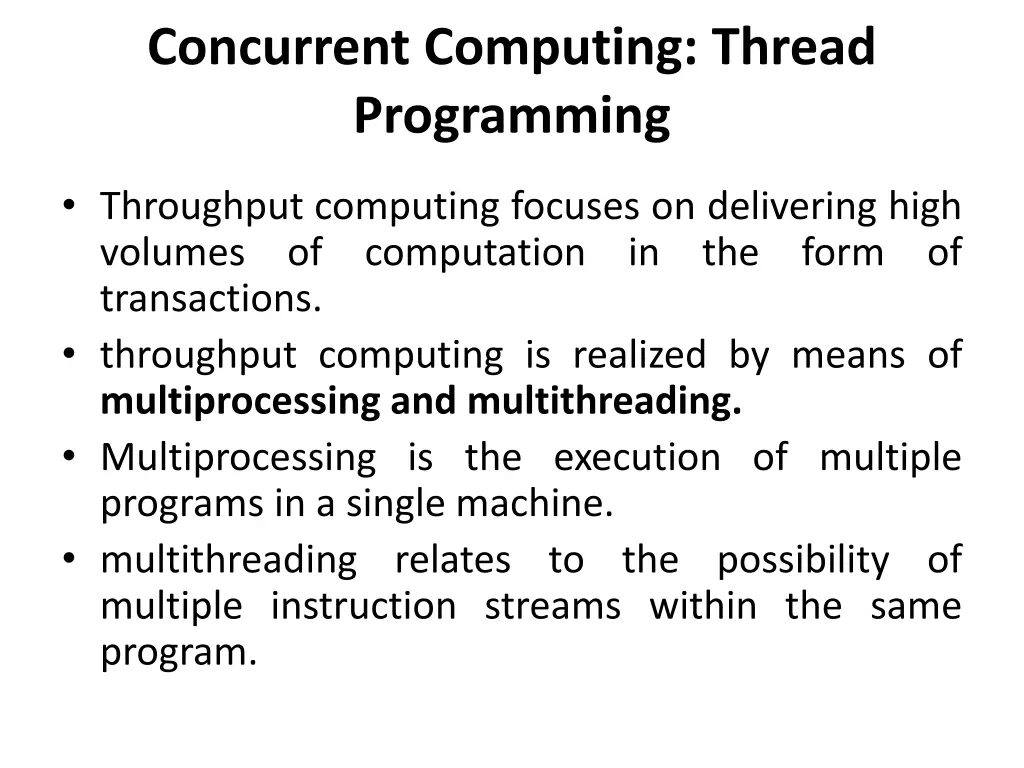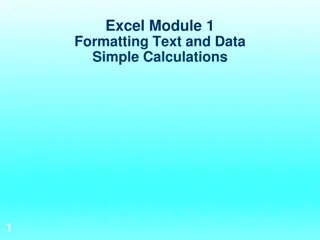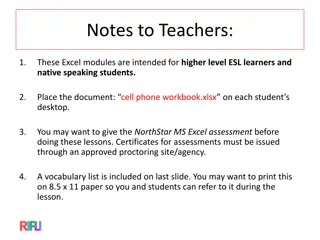
High-Performance Computing: Thread Programming and Multiprocessing Overview
Explore the realm of concurrent computing, focusing on throughput computing achieved through multiprocessing and multithreading. Understand parallelism for single-machine computation, multicore systems, and the significance of thread APIs like POSIX threads in designing parallel and distributed algorithms.
Download Presentation

Please find below an Image/Link to download the presentation.
The content on the website is provided AS IS for your information and personal use only. It may not be sold, licensed, or shared on other websites without obtaining consent from the author. If you encounter any issues during the download, it is possible that the publisher has removed the file from their server.
You are allowed to download the files provided on this website for personal or commercial use, subject to the condition that they are used lawfully. All files are the property of their respective owners.
The content on the website is provided AS IS for your information and personal use only. It may not be sold, licensed, or shared on other websites without obtaining consent from the author.
E N D
Presentation Transcript
Concurrent Computing: Thread Programming Throughput computing focuses on delivering high volumes of computation transactions. throughput computing is realized by means of multiprocessing and multithreading. Multiprocessing is the execution of multiple programs in a single machine. multithreading relates to the possibility of multiple instruction streams within the same program. in the form of
Parallelism for single-machine computation Multiprocessing, which is the use of multiple processing units within a single machine. Asymmetric multiprocessing involves the concurrent use of different processing units that are specialized to perform different functions. Symmetric multiprocessing features the use of similar or identical processing units to share the computation load. Non uniform memory access (NUMA):define a specific architecture for accessing a shared memory between processors. clustered multiprocessing: use of multiple computers joined together as a single virtual computer. Multiprocessor and especially multicore technologies are now of fundamental importance because of the physical constraint imposed on frequency scaling
Multicore systems Multiprocessing is just one technique that can be used to achieve parallelism
Programming applications with threads use of threading as a support for the design of parallel and distributed algorithms. What is a thread? Context switching between threads is a preferred practice over switching between processes.
Thread APIs Portable Operating System Interface for Unix (POSIX) Threads: Standard POSIX 1.c (IEEE Std 1003.1c-1995) addresses the implementation of threads and the functionalities that should be available for application programmers to develop portable multithreaded applications. operations: creation of threads with attributes, termination of a thread, and waiting for thread completion (join operation). Semaphores, conditions, reader-writer locks, supports Synchronization among threads.
POSIX Threads: Programming point of view A thread identifies a logical sequence of instructions. A thread is mapped to a function that contains the sequence of instructions to execute. A thread can be created, terminated, or joined. A thread has a state that determines its current condition, whether it is executing, stopped, terminated, waiting for I/O, etc. Threads share the memory of the process pthread.h
Threading support in Java and .NET Operations performed on threads: start, stop, suspend, resume, abort, sleep, join, and interrupt. Java: java.util.concurrent package .NET Parallel Extension framework
Techniques for parallel computation with threads Decomposition is a useful technique that aids in understanding whether a problem is divided into components(or tasks) that can be executed concurrently. Two main decomposition/partitioning techniques are domain and functional decompositions.
Domain decomposition Domain decomposition is the process of identifying patterns of functionally repetitive, but independent, computation on data. The master-slave model: The system is divided into two major code segments. One code segment contains the decomposition and coordination logic. Another code segment contains the repetitive computation to perform. A master thread executes the first code segment. As a result of the master thread execution, as many slave threads as needed are created to execute the repetitive computation. The collection of the results from each of the slave threads and an eventual composition of the final result are performed by the master thread.
Matrix Multiplication-embarrassingly parallel the repetitive operation is the computation of each of the elements of the resulting matrix. These are subject to the same formula, and the computation does not depend on values that have been obtained by the computation of other elements of the resulting matrix.
Matrix Multiplication-Multithreaded Program Define a function that performs the computation of the single element of the resulting matrix. Create a double for loop (the first index iterates over the rows of the first matrix and the second over the columns of the second matrix) that spawns a thread to compute the elements of the resulting matrix. Join all the threads for completion, and compose the resulting matrix.
Functional decomposition Functional decomposition is the process of identifying functionally distinct but independent computations. The focus here is on the type of computation rather than on the data manipulated by the computation. f(x)=sin(x)+cos(x)+tan(x) The program computes the sine, cosine, and tangent functions in three separate threads and then aggregates the results.
Multithreading with Aneka Aneka, as middleware for managing clusters, grids, and clouds, provides developers with advanced capabilities distributed applications. It lets you write multithreaded applications the traditional way, with the added twist that each of these threads can now be executed outside the parent process and on a separate machine. threads are independent processes executing on different nodes and do not share memory or other resources. for implementing
Aneka-thread programming model This model introduces the abstraction of distributed thread, also called Aneka thread, which mimics the behavior of local threads but executes over a distributed infrastructure. Thread Programming Model, the application is designed as a collection of threads, the collective execution of which represents the application run. Threads are created and controlled by the application developer, while Aneka is in charge of scheduling their execution.
The Thread Programming Model exhibits APIs that mimic the ones exposed by .NET base class libraries for threading. System.Threading.Thread class AnekaApplication<T,M> Aneka.Threading.AnekaThread class, which represents a distributed thread. Aneka.Threading.ThreadManager class AnekaApplication<AnekaThread,ThreadManager>
Thread life cycle Unstarted->[Started]->[Queued]-> Running->Completed/Aborted/Failed.
Thread synchronization: The .NET base class libraries provide advanced facilities to support thread synchronization by the means of monitors, semaphores, reader-writer locks and aneka provides join method. Thread priorities: System.Threading.Thread class supports thread priorities. Values of the ThreadPriority enumeration: Highest, Above Normal, Normal, Below Normal, or Lowest.
Aneka threads application model AnekaApplication<W,M> application reference class for all the programming models To develop distributed applications with Aneka threads, use AnekaApplication<AnekaThread, ThreadManager> template. Configuration class: This class contains a set of properties that allow the application class to configure its interaction with the middleware. such as the address of the Aneka index service, which constitutes the main entry point of Aneka Clouds; the user credentials required to authenticate the application with the middleware; class, which is the






















